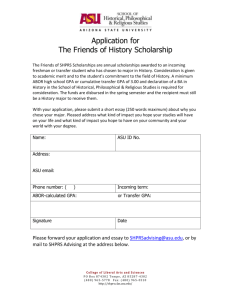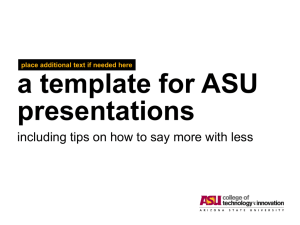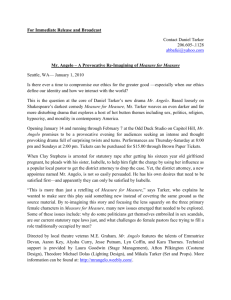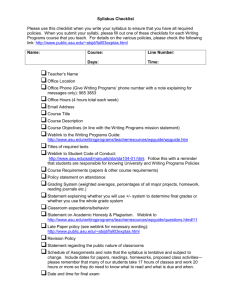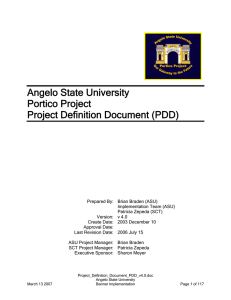ASU's Quality Enhancement Plan
advertisement
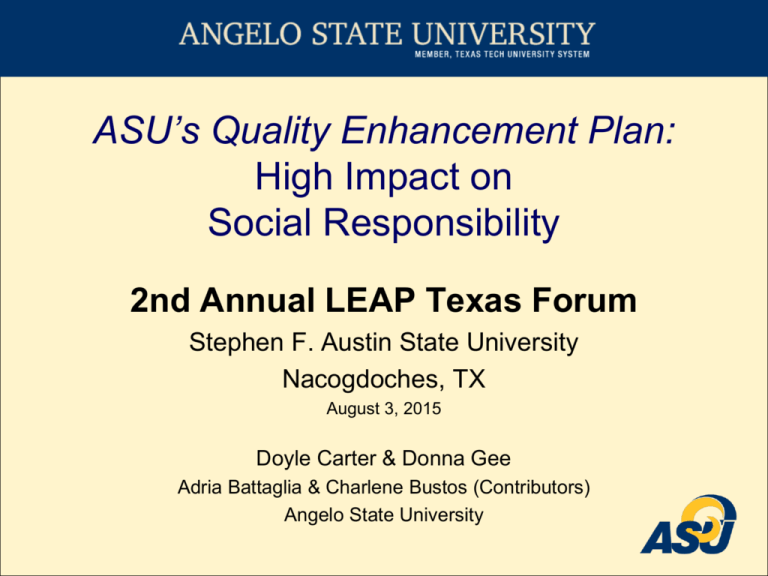
ASU’s Quality Enhancement Plan: High Impact on Social Responsibility 2nd Annual LEAP Texas Forum Stephen F. Austin State University Nacogdoches, TX August 3, 2015 Doyle Carter & Donna Gee Adria Battaglia & Charlene Bustos (Contributors) Angelo State University Presentation Overview Abstract Angelo State University’s Quality Enhancement Plan, aka, CONNECT! proposes to enhance student learning by embedding high impact practices (HIPs) into graduate and undergraduate courses. The student learning goal of CONNECT! is Social Responsibility, which also serves as one of the objectives of the Texas Core Curriculum. Therefore, CONNECT! pedagogies include HIPs such as service-learning projects and internships. The presenters will: 1) provide information regarding the infusion of LEAP principles and practices into the CONNECT! initiative, and 2) track the development, implementation, and assessment of high impact, CONNECT! projects conducted as components of recent courses. Agenda 1. ASU Profile 2. LEAP and CONNECT! 3. Examples of CONNECT! Courses About ASU Location: San Angelo, TX (population: 100,000) Founded: 1928 Member: Texas Tech University System Hispanic Serving Institution (29% Hispanic student pop.) Degree Programs: Bachelors: 41 (100+ majors/concentrations) Masters: 21 Doctoral: 1 Enrollment: 6,494 from 47 states & 29 countries Mean ACT/SAT, undergraduates: 21/980 Financial Aid: 86% of undergraduates First Generation: 46% of undergraduates Retention: 62% 1st to 2nd Year Faculty/Student Ratio: 18:1 Faculty: 281 full-time; 70 part-time Athletics: NCAA Division II Carnegie Community Engaged Campus Campus and Community: ASU’s Plan to Enhance Student Learning through Community Engagement ASU’s QEP Title CONNECT! Campus and Community, aka, CONNECT! Purpose Connect students, faculty and staff with the local, regional, national, and global communities to enhance student learning and better serve those communities. Goal Connected students will become socially responsible citizens. Objectives CONNECT! will have a positive impact on student learning. CONNECT! will have a positive impact on ASU’s community engagement outcomes. Strategic Alignments LEAP Outcomes/Texas Core Curriculum Objectives (Social Responsibility) Carnegie Community Engagement Indicators Texas Tech University System Priorities (Outreach & Engagement) ASU Mission, Values, Strategic Plan & Learning Goals Our Learning Model The Cycle of Intentional Learning (AAC&U, 2004) Goals/ Outcomes Curricular Design Assessment Pedagogy Goals/Objectives Implementation Strategies & Inputs CONNECT! Courses…embed some type of active engagement with the community (campus, local, regional, national, or global) that is coupled with some form of critical reflection. Faculty Incentive Programs CONNECT! Fellowships (Curricular Focus) CONNECT! Department Grants (Curricular and Co-curricular Focus) Engagement Pedagogies (CONNECT! HIPs) Connect-2-Campus (2015 pilot in selected freshman seminars) Co-curricular Connections Learning Excursions/Study Abroad Service-learning Internships/Practica, etc. Community-based Research Implementation Strategies & Inputs, (Cont.) Resources Current Staff (high tech/high touch) .5 Director .5 Administrative Assistant Information Sharing Tools CONNECT! Faculty Support Hub (housed in Blackboard) Center for Community Engagement website (angelo.edu/connect) Events CONNECT! Student Showcase (23 student presentations in F’14) CONNECT! Faculty Reception Current Faculty N = 21, representing all 6 colleges Most teach one CONNECT! course per semester M&O and Faculty Incentives Course Inventory N = 27 (projected for fall 2015) Modes of delivery: face-2-face, blended & online Course types: core, major/minor, freshman to doctoral Assessment Plan The direct assessment of student learning is the central component of the CONNECT! Assessment Plan. Students enrolled in CONNECT! courses submit a reflection paper or similar artifact for both course-level and program-level assessment. For program-level assessment, a locally-generated rubric (derived from two of the AAC&U VALUE rubrics) is used by a panel of faculty jurors to rate the students’ ability to demonstrate Social Responsibility. In applicable courses, community partners assess the students’ performance and provide programmatic feedback. Indirect student learning assessment strategies include: The CONNECT! Student Survey (same six indicators as Social Responsibility Rubric) National Survey of Student Engagement (NSSE) administered in spring of odd # years Outputs & Outcomes (Impacts) Enrollments Fall Spring Summer 2012-13 (Pilot) 140 98 238 2013-14 461 387 848 2014-15 524 418 2015-16 (projected) 700+ 15 Total 957 Objective/Outcome 1 – Impact on Student Learning: Students are achieving at or above target levels on the six indicators of Social Responsibility (direct and indirect). NSSE data from spring 2015 will be available this fall. Objective/Outcome 2 – Impact on the University: ASU achieved the Carnegie Elective Classification for Community Engagement in January 2015. Our Carnegie application substantiates the impact that our focus on community engagement is having on students, faculty, staff, and the community. EDG 6381 Multicultural Education/ED 4381 Linguistically Diverse Learners (Study Abroad) Dr. Donna Gee & Dr. Charlene Bustos, CONNECT! Fellows Course Outcomes Demonstrate intercultural awareness and communication. Taylor communication strategies based on cultural norms and values. Demonstrate effective engagement in the community, both locally and globally. Syllabus EDG 6381/ED 4381 CONNECT! Activities Participation in 5 hours of community service in the local community before leaving for the study abroad School supply and book drive for primary and secondary schools in Fiji Cultural Perspective Project consisting of: Observations and field notes New word log Photographs Reflective essay Interview (graduate students only) Summary presentation (graduate students only) Expanding Social Responsibility One graduate student and one undergraduate student became ambassadors for Give More HUGS, a non-profit organization that focuses on education Additional school supplies and books were donated Permission was received from the airlines for students to bring an extra carry-on bag of school donations Experiencing Social Responsibility Students participated in the school supplies and book drive and organized donations to a village primary school and secondary school (college). Connecting with Global Communities EDG 6381/ED 4381 Assessments CONNECT! Student Survey Cultural Perspective Reflective Essay – Cultural Perspective Rubric COM 2301 Public Speaking & Civic Engagement Dr. Adria Battaglia, CONNECT! Fellow COM 2310 is a Core Course Alignment with Core Objectives: Critical Thinking, Communication Skills, Team Work, Personal Responsibility, and *Social Responsibility *by department choice CONNECT! Pedagogy: Service-learning CONNECT! Assignment: Community Partnership Project Course-level Assessment: Group- Informative Speech, Persuasive Speech, Community-Partner Presentation: Individuals- Reflection Paper Program-level Assessment: Social Responsibility Rubric (Reflection Paper), CONNECT! Student Survey, Community-Partner Evaluation of Student Learning Dr. B’s Video KIN 3333 Motor Development Dr. Doyle Carter KIN 3333 is required for all kinesiology majors Alignment with Social Responsibility Indicators: SR3.1: Connecting Learning and Engagement and SR3.2: Community Action and Reflection CONNECT! Pedagogy: Co-curricular Connections (curricular/co-curricular integration) CONNECT! Assignment: CONNECTING *Social and Motor Development *While the course focuses on motor development, social development is part of the course content, as are cognitive and moral development. Course-level Assessment: Reflection Paper worth 10% of final grade; graded using an instructor-developed rubric specific to the assignment Program-level (CONNECT!) Assessment: Social Responsibility Rubric and CONNECT! Student Survey Selected Resources Association of American Colleges and Universities (2011). VALUE: Valid Assessment of Learning in Undergraduate Education. Association of American Colleges and Universities (2004). Taking responsibility for the Quality of the baccalaureate degree. Washington, DC: Author. Battistoni, R.M., Gelmon, S.B., Saltmarsh, J., Wergin, J. & Zlotkowski, E. (2003). The Engaged Department Toolkit. Providence, RI: Campus Compact. Beere, C.A., Votruba, J.C. & Wells, G.W. (2011). Becoming an Engaged Campus: A Practical Guide for Institutionalizing Public Engagement. San Francisco, CA: Jossey-Bass. Carnegie Foundation for the Advancement of Teaching (2013). Elective Community Engagement Classification 2015 Documentation Reporting Form. Kuh, G.D. (2008). High-Impact Educational Practices: What They are, Who Has Access to Them, and Why They Matter. Washington, DC: AAC&U. Contact Information Dr. Doyle Carter Professor of Kinesiology; Director, Center for Community Engagement/QEP email: doyle.carter@angelo.edu Dr. Donna Gee Professor of Education email: donna.gee@angelo.edu Center for Community Engagement www.angelo.edu/connect 325-942-2708


